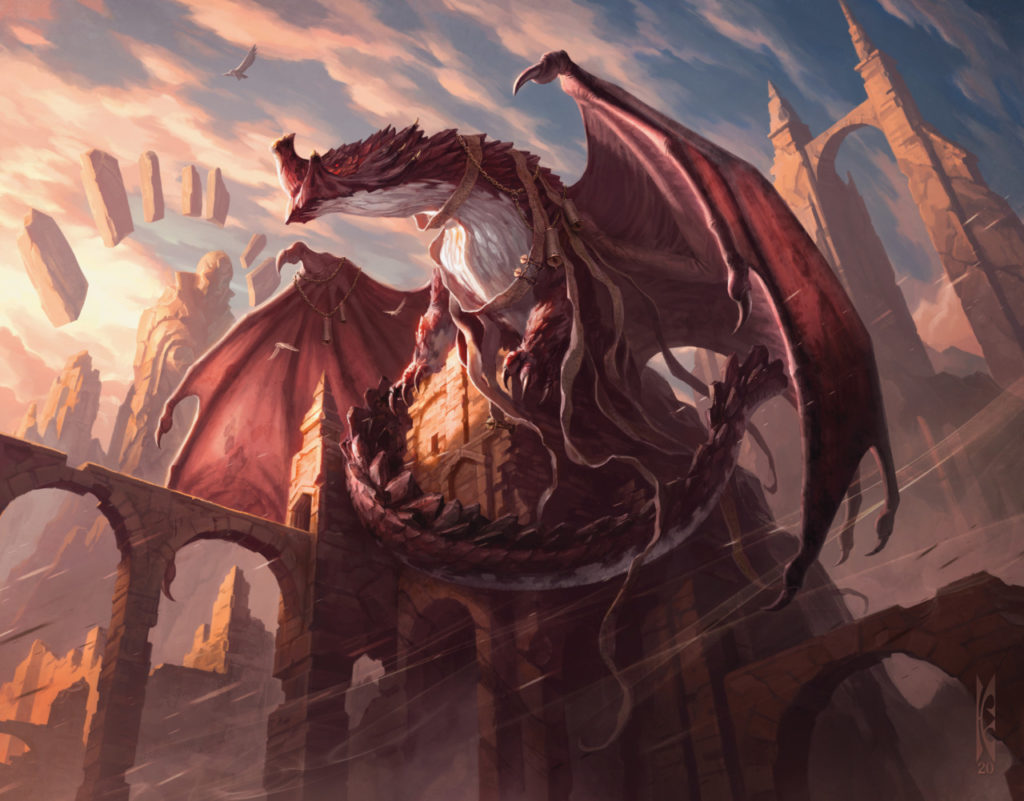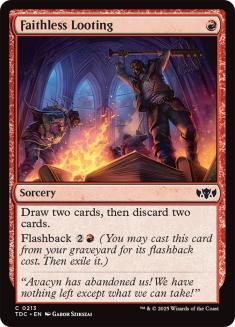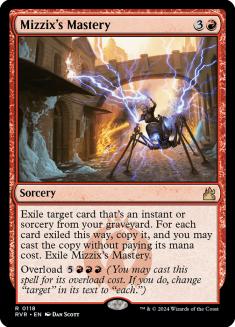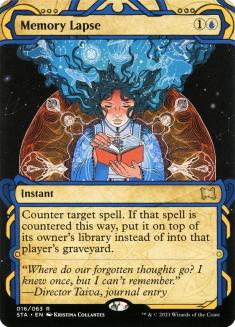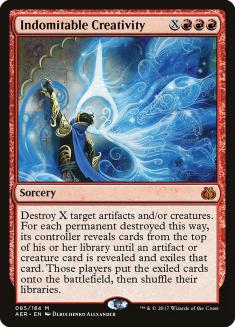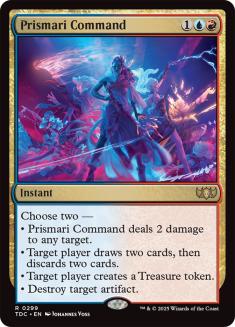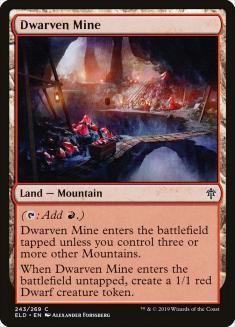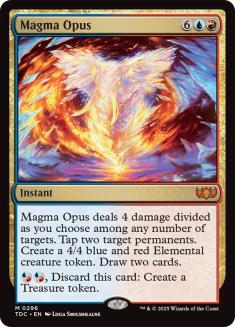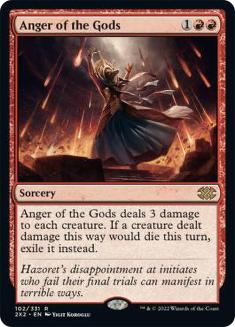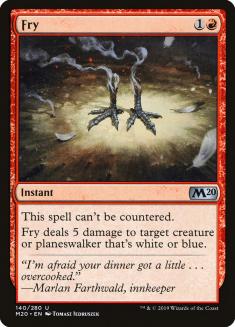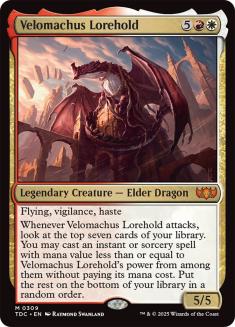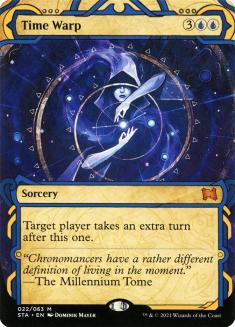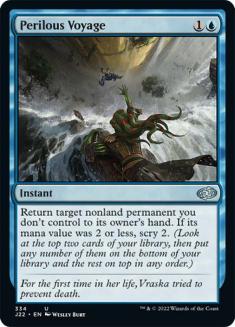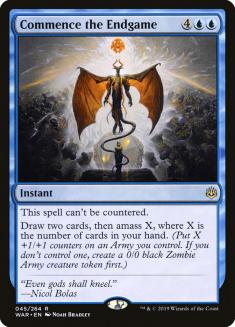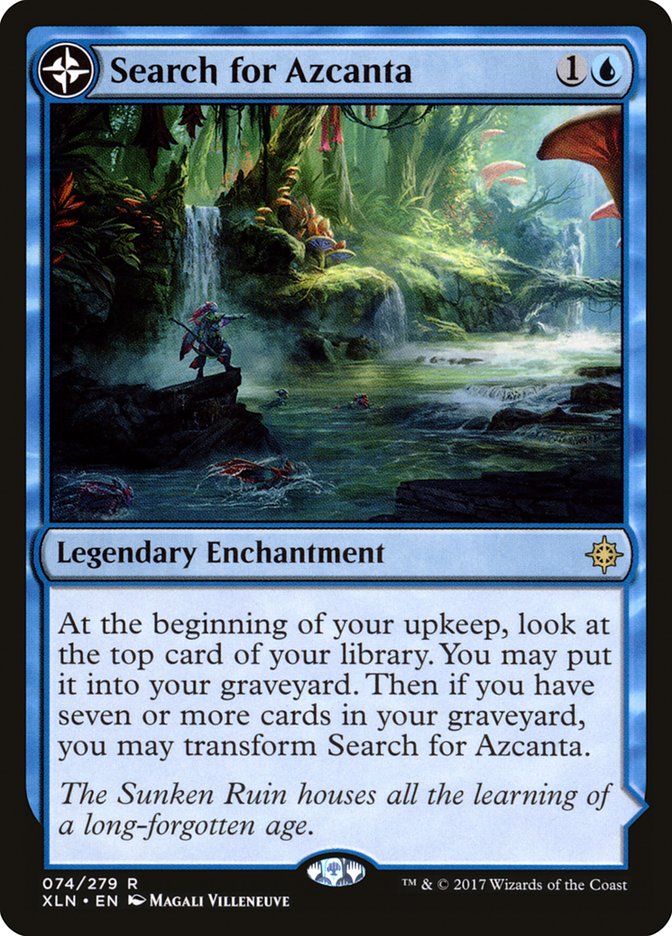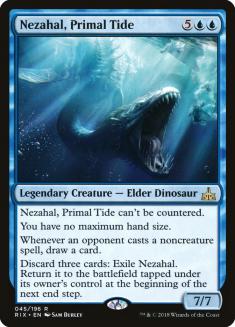Historic was, for most of its existence, a relatively open format. There was always a best deck (Mono-Red Goblins, Sultai Midrange, Jund Food, and Orzhov Auras at various points), but many different strategies were viable at all points of the spectrum. With the advent of the Mystical Archive, this changed — some of the cards that were released were more powerful than everything else by enough that playing any deck that couldn’t include them became a mistake. The main culprit here is Brainstorm, but Faithless Looting, Mizzix’s Mastery, and Memory Lapse are also at the top of the list. In the end, you can still play a variety of decks in Historic, but I would recommend choosing a deck that includes at least one of these cards, and ideally more than one.
It is following this philosophy that our team arrived at our deck for the Strixhaven Championship. This was the exact list we played:
Creatures (2)
Lands (26)
Spells (32)

My personal record with the deck was 5-2, losing two mirrors (one 75 card-mirror to Matt Nass). The overall deck had close to a 60% win rate in the tournament and put five people in the Top 8 when it was only 15% of the field at the start of the tournament. Even though it was a mixed-format tournament, which means the Top 8 doesn’t tell the whole story, there’s no question in my mind that Jeskai Indomitable Creativity is the deck to beat in Historic moving forward, and if you don’t want to play it yourself you should at least understand how it works.
This deck is, for most intents and purposes, a combo deck. The primary combo is simply Indomitable Creativity and a token generator.
+
If you cast Indomitable Creativity on any of those four, you’re going to hit Velomachus Lorehold. You can then immediately attack and you have seven looks to find Time Warp or Mizzix’s Mastery for Time Warp (assuming one is already in the graveyard). If you hit, you cast that card for free and usually win the game on the spot, because your next attack is going to find card drawing even if it doesn’t find another Time Warp, and at that point you have all your mana up (I don’t believe I’ve ever lost a game in which my first attack generated an extra turn).
The actual math is going to depend on how many cards you’ve drawn and how many copies of these cards you’ve seen, but you’re roughly 40% to hit a Time Warp and roughly 65% to hit either Time Warp or Mizzix’s Mastery (remember that you can Brainstorm these cards to the top of your deck as well).
If you miss, your punishment is that you get to continue playing. Several decks struggle beating the 5/5 alone (such as Selesnya Company), and even if you don’t hit a Time Warp, you get to hit something that increases your chances of winning the game. For example, against aggro decks after sideboard, hitting Anger of the Gods is usually almost as good as hitting Time Warp. As a general rule, you’re usually going to win the game when you attack with Velomachus Lorehold, though not always.
The secondary combo is Mizzix’s Mastery + Magma Opus.
A lot of the time, you discard Magma Opus to make a Treasure on Turn 2 and then you simply cast Mizzix’s Mastery to effectively win the game. You don’t literally win, but some decks simply can’t recover from this. For example, imagine you’re playing Gruul Aggro and you go Turn 1 Pelt Collector, Turn 2 Voltaic Brawler. This is a pretty reasonable start. Your opponent discards Magma Opus at the end of your turn and, on their turn, they kill both your creatures, make a 4/4, and draw two cards. How do you get back in the game? It’s very hard, especially since the 4/4 also serves as an Indomitable Creativity target for later in the game if they ever draw that.
One key part of the deck is that every combo piece serves multiple roles. Take Magma Opus, for example — it can act as a token maker for Creativity or as a target for Mizzix’s Mastery. Mizzix’s Mastery, on the other hand, works with Magma Opus, but it also works as a card to hit with Velomachus Lorehold or as an eight-mana win-the-game button, which comes up more often than you’d expect. Sometimes you have a Treasure on the battlefield and on Turn 5 you play Time Warp, Time Warp, Overload Mastery, which nets you two extra turns in the bank on top of whatever Brainstorms / Prismari Commands / Magma Opuses you’ve cast before in the game, and that will win you the game basically every time.
Even Velomachus Lorehold and Indomitable Creativity play multiple roles in the deck. Velomachus is a combo piece, but you’re quite capable of casting it, especially with the Treasures. Creativity is your combo but it can also remove pesky permanents, such as Grafdigger’s Cage and Archon of Emeria. Archon of Emeria, in particular, would normally be a nuisance, but if you’re playing Creativity you can just pay one extra mana and get rid of it en passant. On top of that, if you’re playing versus a deck without creatures (such as Jeskai Control) you can often Plague Wind them with Indomitable Creativity. Because of all these potential interactions, this deck often takes a while to get used to, but just remember not to pigeonhole yourself into one particular role or win condition — this deck has several and part of its strength is that it can be so flexible.
Our list is very tuned towards the blue matchups, because in every other matchup you can just combo them out. Because of this, I don’t like having removal spells like Anger of the Gods or Fire Prophecy in the maindeck. I expect this trend to continue moving forward.
VS Izzet Phoenix
Izzet Phoenix is normally a pretty good matchup for you. Keep in mind that, as this deck gets more and more popular (as it’s wont to), people will adapt more and more to it — we might see a higher number of Lightning Axes, counterspells, or several copies of maindeck Fry and Brazen Borrower. If this is the case, then matchups that are normally good might become bad. For the moment, however, I’m happy playing against Izzet Phoenix.
In Game 1, they’re usually at the mercy of your combo with the exception of up to two copies of Lightning Axe. Even if they do have something like Fry, what often happens is that the delay they must inflict on themselves to be able to hold the mana up means you can just Mizzix’s Mastery them into oblivion, which creates a scenario in which if they try to pressure you you can combo them and win, and if they play it slowly you can overload a Mastery and win. To be able to win, they usually require a lot of early pressure and disruption, which is not so common.
Out (on the play):
In (on the play):
Out (on the draw):
In (on the draw):
Prismari Command is much better on the play since it can kill Sprite Dragon, whereas on the draw it has basically no chance of doing that. If they have a lot of disruption for the combo, you can have four Shark Typhoon all the time and maybe even some Commence the Endgame.
VS Jeskai Indomitable Creativity
There aren’t a whole lot of answers in either deck in Game 1, so the game usually ends by combo, but you always have to be mindful of Prismari Command as a way to destroy both a Treasure and a Dwarf token.
Out:
In:
The sideboard games are very tricky and I have to admit I don’t know what the best configuration actually is. There are several different types of games and in each type of game you want one different combo, so maybe the best approach is to just leave two of everything in your deck, but I’ve had more success taking out one of the combos entirely (either the Creativity and Velomachus or the Magma Opus and Mizzix’s Mastery). Right now I think taking out Creativity is the best, but I’ve also toyed around with taking out all the Opus and Masteries instead and that also felt reasonable.
If you’re playing a three-game set, it might also pay off to change what you do between Game 2 and Game 3, so your opponent plays around the wrong thing. For example, they might see that you have no Creativity in Game 2 and then feel safe tapping out in Game 3, but you punish them by bringing in the Creativities again. The key is that your sideboarded configuration has to be coherent; you can’t have Creativity but no token makers or Velomachus but not enough hits to make it worth it.
After sideboarding, Shark Typhoon becomes the most important card. It’s very hard to combo someone out, since there’s so much disruption (some of which is uncounterable), which means you need to find another avenue to win the game. Our team chose to play two Commence the Endgame as extra Shark Typhoons, as well as two Perilous Voyage for Typhoon fights.
Some teams chose to play Nezahal, Primal Tide instead. I think that, as far as being a bullet in the mirror, Commence the Endgame is better. If you tap out for Nezahal, you risk just losing the game (either to the main combo or to Time Warp + overloaded Mastery), not to mention that Commence sometimes just outgrows it. When I played versus Kai Budde in the tournament, for example, he had Nezahal but couldn’t attack due to the threat of Commence creating an 8/8 blocker and eventually I just won the game through it with flyers. If you’re playing versus the Nezahal version, it might be worth hedging a bit and leaving some parts of each combo still in your deck rather than taking out all Creativities and Dragons, as you want to be able to punish them if they tap out for it.
The benefit of Nezahal is that it’s still a creature, so you can Creativity into it. This becomes especially relevant as a post-attack play; normally, if a person attacks their Shark into a bigger Shark from hand, blocking is free since Velomachus is not nearly as threatening post-combat. However, if their creature is Nezahal, you can’t tap out to block, because a post-combat Creativity will still likely win the game. It also doesn’t demand anything else (such as Time Warp), which makes sideboarding cleaner; Velomachus is a lot weaker if you trim some of its best targets.
The other upside of Nezahal is that, if you’re playing a matchup where tapping out is not that bad (such as Jeskai Control, where they can’t punish you), it’s normally going to be a better card.
Overall, my inclination is that Commence the Endgame is better, but I’m not 100% sure. It’s possible (and likely, in my opinion) that both should be in the sideboard. Having as much as one Nezahal would already make your matchup versus Jeskai significantly better as it’s the best card to hit with Creativity and it gives you an entirely new dimension while sideboarding. The Dragon is much weaker after sideboard for various reasons (you have fewer hits and people have more disruption) so the ability to make the swap makes sense, but Commence is still very good so I like having access to both.
VS Gruul Aggro
I think this is a good matchup as well. They can’t kill you quickly enough and they have no disruption for you whatsoever other than Scavenging Ooze for Mizzix’s Mastery. You can definitely lose, especially on the draw, but I think you’re heavily favored.
Out:
In:
After sideboarding, not much changes. Be more mindful of Fry and enchantment hate (Roiling Vortex, Cindervines), but the same thing that happened with Phoenix applies; if they just keep mana up to play something like Fry, they won’t pressure you enough and you’ll win anyway. The Opus + Mastery combo, in particular, is very strong against them, and sometimes you cast it and win even if you have to take damage from Vortex to do it.
VS Selesnya Company
This matchup is worse than Gruul Aggro because their disruption creatures can be very annoying. Archon of Emeria stops Mastery and Velomachus to an extent, Thalia is a nuisance, Reidane works against you, etc. I think it’s probably about even when all is said and done — whoever is on the play is favored. Remember that you can Creativity their Archon as well for one extra mana!
Out:
In:
If you have more Fry in the sideboard, this matchup gets better. I don’t like Aether Gust as almost every problematic creature is white. Mizzix’s Mastery is not great since it gets hosed by every single one of their hate cards, so you could take them all out if you had other things to bring in. Perilous Voyage is pretty good here as it also answers problematic permanents such as Deafening Silence.
VS Jeskai Control
This matchup is hard to predict because it really depends on what kind of Jeskai Control they’re playing — they have the tools to beat you in their colors, but are they willing to warp their decks to the extent this would be necessary? In any case, your plan is usually to play slow and try to force something through. They don’t have a ton of hard counters and they can’t jam Teferi because you Memory Lapse it and then kill them, so you just play draw-go until it gets to a point where you can cast a Magma Opus at the end of the turn to force their hand. Against most Jeskai lists, you can use Creativity as a removal spell for their Sharks and it won’t turn into anything.
Out:
In:
After sideboarding, it again becomes a Shark Typhoon game, similar to the mirror, so we want Perilous Voyage even if it doesn’t have a lot of big things to bounce. Having Nezahal would be significantly better in this matchup, as it’s easily castable (they can’t really punish you for tapping out) plus it’s a much better Creativity target, as it doesn’t die to Fry and can’t be Aether Gusted.
Moving Forward
Moving forward, I expect this deck to be slightly weaker than it was this weekend (since people will be more prepared), but it should still remain a top contender (the core is too strong for it not to be). I liked our maindeck a lot, but I would try to add one Nezahal to the sideboard because I think it’d give you the ability to have much better Creativities in the blue mirrors. I would probably remove a Search for Azcanta for this, and then just play two Commence the Endgame and one Nezahal. This gives you enough flexibility with sideboarding against any other blue deck that it’s worth it.
Past that, I would keep the deck as-is, and if you are a fan of combo decks (or just a fan of winning), I definitely recommend giving it a try!

